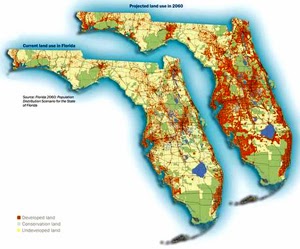The following article, which features Dr. Doug Tallamy's book,
Bringing Nature Home, was submitted by Karina Veaudry, FNPS Landscape Committee Chair. Excerpts of Tallamy’s original text were reprinted with his permission. For part 1 of the article, click
HERE.
 |
Landuse in Florida today and predictions for 2060; the
rust color depicts developed land, green is conservation
and yellow is undeveloped. |
Your Role in Building Biological Corridors: Networks for Life
Throughout the U.S., we have fragmented the habitats that support biodiversity by the way we have landscaped our cities, suburbs, and farmland. This is a problem because isolated habitats cannot sustain themselves or support populations large enough to survive normal environmental stresses. We can reconnect viable habitats by expanding existing greenways, building riparian corridors, and by changing the landscaping paradigm that dominates our yards and corporate landscapes. Replacing half of our lawns (areas that are essentially barren and ecologically sterile) with plants that are best at supporting food webs would create over 20 million connected acres of connectivity and go a long way toward sustaining biodiversity in the
future.
Re-designing Suburbia
 |
| Illustration from http://www.restoringthelandscape.com |
What will it take to give our local birds and animals what they need to survive and reproduce on our properties?
NATIVE PLANTS, and lots of them. This is a scientific fact deduced from thousands of studies about how energy moves through food webs. Here is the general reasoning: All animals get their energy directly from plants, or by eating something that has already eaten a plant. Insects are responsible for passing energy from plants to animals that can’t eat plants. This is what makes insects such vital components of healthy ecosystems. So many animals depend on insects for food (including 96% of all terrestrial birds) that if insects were removed from an ecosystem, the resultant ecosystem would be doomed.
 |
| Above: Lagerstroemia indica; below: Prunus umbellata |
But that is exactly what we have tried to do in our suburban landscapes. For over a century, we have favored ornamental landscape plants from China and Europe over those that evolved right here. If all plants were created equal, that would be fine. But every plant species protects its leaves with a species-specific mixture of nasty chemicals. With few exceptions, only insect species that have shared a long evolutionary history with a particular plant lineage have developed the physiological adaptations required to digest the chemicals in their host’s leaves. They have specialized over time to eat only the plants sharing those particular chemicals. When we present insects from Florida with plants that evolved on another continent, chances are those insects will be unable to eat them. We used to think this was good, the mantra being, "Kill all insects before they eat our plants!" The truth is that an insect that cannot eat part of a leaf cannot fulfill its role in the food web. We have planted
millions of Crape Myrtles (
Lagerstroemia indica), a species from China that supports very few insect herbivores, instead of our native flowering Plum tree (
Prunus umbellata), which supports over 450 species of birds, butterflies, moths and pollinators. This is but one example. Non-native plants create an ecological hole because they fail to provide the prerequisite food and nesting sources for existing local wildlife.
Your Yard Has a Function
 |
The Florida Scrub Jay is a federally-listed endemic
species - it needs NATIVES! |
In the past we didn’t design home landscapes to reflect the critical ecological roles they play. If we hope to avoid future wildlife extinctions and create a situation from which humans are not likely to recover, then we need to change our approach to home landscape design. By replacing unnecessary lawn with densely planted woodlots, we can foster biodiversity and fill the habitat void.
But we MUST do this by landscaping our properties with native trees and plants.
Studies have shown that even a modest increase in the native plant cover on a suburban property will significantly increase the number and species of breeding birds present, including birds of conservation concern. As gardeners and stewards of our land, we have never been so empowered to help save so many species from extinction, and the need to do so has never been so great.
All we need to do is plant natives!
---
posted and edited by Laurie Sheldon








Comments